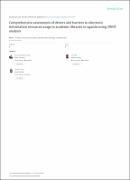| dc.description.abstract | The high costs of printed Textbooks have negatively affected the education and library services in many developing countries, forcing institutions and universities to utilise electronic information resources (EIRs) to offer library information services and resources to library users. Many universities in northern Uganda adopted EIRs without evaluating them. This study, therefore, seeks to assess the drivers and barriers to EIR usage in academic libraries in Uganda by analysing their strengths, weaknesses, opportunities, and threats (SWOT). The study employed a descriptive design to collect quantitative data and a stratified random sampling technique to select the sample size. A structured questionnaire was designed using Google Forms and administered online to the Muni and Lira universities’ teaching staff and final-year students, where 103 were filled by teaching staff and 248 by final-year students. The data collected were analysed using the SPSS Version 28 and RStudio software. Statistical techniques like descriptive analysis were used in the data analysis. The results for the mean ≥ 3.41 were considered statistically significant. The study findings show that most respondents agreed that librarians expose them to all the library EIRs and that it was essential to access EIRs to benefit from its services. The study also identified knowledge and skills, the relevance of EIRs, availability of technological infrastructure and resources, awareness and adaptation, perceived ease of use and access, previous experience, institutional policies, and perceived quality content as the critical drivers for the usage of EIRs in academic libraries. The results of the SWOT analysis identified internal factors (i.e., strengths and weaknesses) and external factors (i.e., opportunities and threats) affecting EIR usage in Ugandan academic libraries. The survey recommends that for the successful adoption and implementation of EIRs in Ugandan libraries, there should be a reliable power supply and internet connectivity for easy access to the EIRs, purchase of more computing devices for accessing the EIRs, training and supporting the users of EIRs in universities; proper accountability and use of donor funds meant for payments of EIRs; and so on. These findings generated ideas that the universities, libraries, and library consortia can use in decis | en_US |

